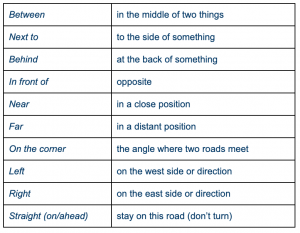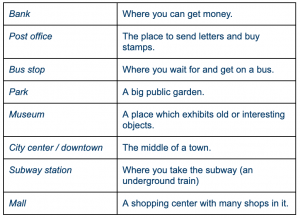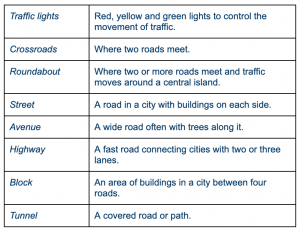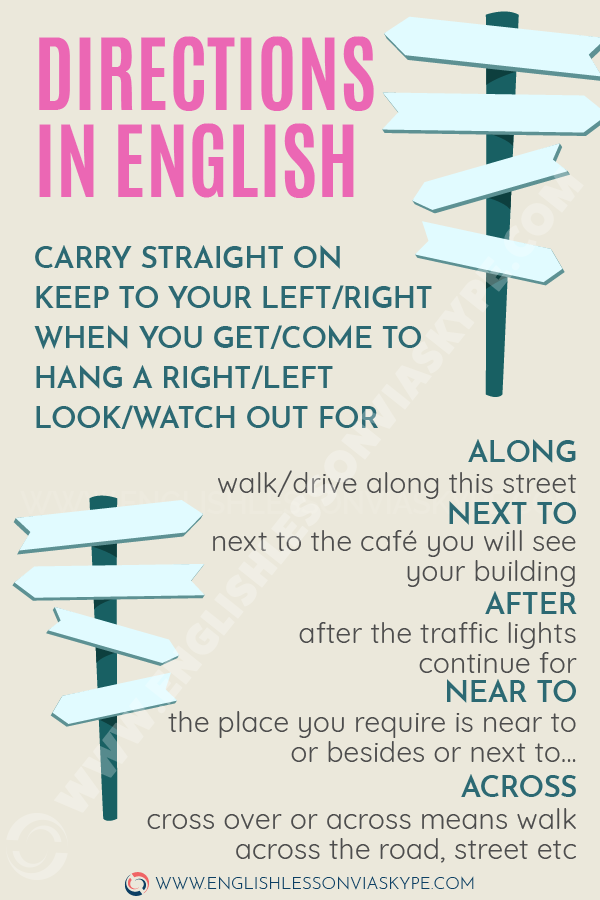
It’s also helpful to know some common places people visit in a city, such as the following:

Here are some examples:
- Go along the street until you reach the traffic lights.
- You’ll see a bank on the left.
- It’s about two blocks from here.
- I prefer going to the airport on the highway because it’s faster.
Some prepositions and adverbs can also help when you’re giving directions:

For example,
- My office building is in front of the mall.
- Go straight on for about one kilometre.
- The cinema is next to the bank.
Asking for directions
When you ask for directions, remember above all to be polite. So start by saying one of the following phrases:
- Hello. Can you help me, please?
- Good morning. May I ask for some help?
- Excuse me, could you help?
Once you have someone’s attention, you can ask for help to reach your destination. You can do that by using one of these phrases:
- Could you tell me how to get to the bank?
- Do you know where the museum is?
- We can’t find the subway station. Is it near here?
- Where can we find a park near here?
If you’re not sure you’re going in the right direction, you can make sure by asking:
- Are we on the right road to the city center?
- Is this the right way to the mall?
- What’s the best way to get to the airport?
Giving directions
In the same way that you need to ask directions when you travel abroad, foreigners visiting your city might ask you directions, and what better way to practice English than to help them? 🙂
Here are some common phrases you can use:
- Go past the cinema. (Pass the cinema.)
- Go along this road.
- Go straight on/ahead. (Stay on this road – don’t turn.)
- Go through the tunnel.
- At the roundabout, take the first exit.
- Turn left at the crossroads.
- Take the second right.
- It’s on your left.
- You’ll see it in front of you.
- It’s on the other side of the road.
- You’re going the wrong way.
Find this and other giving directions exercises in English Exercises .org
- Directions - prepositions
- Giving and asking for directions
- How to give directions
- Following Directions - getting around (with answers)
- Giving Directions - exercise
- Giving Directions - speaking game
- Talk English - directions
- BBC - giving directions
- About.com - directions
- Directions - basics
- Giving Directions
- Business English - directions
- town map
- Directions game
- Directions - Dropbox
- Direction worksheets and exercises **
Housing, neighborhoods and directions lessons

ESL teaching exercises/worksheets for neighborhoods, homes and "where we live"
Other teaching ideas for communities, transportation, homes and "where we live"
Giving Directions: mapping lessons & other ideas for ESL teachers
- Directions 1 (easy) - Révision des prépositions et des magasins (esl-lab)
- Directions 3 (medium) - Révision des prépositions (esl-lab)
- Directions 2 (difficult) - Utilisation des prépositions (esl-lab)
- A story with a cat and a mouse - read to you. (révision des prépositions) - (kizclub)

- Directions (with exercises) - (esl-lab) :
- Directions 1 (E)
- Getting Around Tokyo (E)
- Directions 3 (M)
- Where's the movie theater? (D)
- Directions 2 (D)
- Taking the Train (E)
- All About Prepositional Phrases, with Over 60 Examples

"This article contains every common preposition in the English language. Isn’t it nice to know that you can learn them all?
A list of every common verb or every common noun would be very long…"
+ List of Prepositions and Prepositional Phrases Examples
(dailywritingtips.com) - SOME OTHER IMPORTANT IDEAS in PICTURES : Pronouns, Operators, Directions
(ogden.basic-english.org)
- Directions - a lesson with AUDIO
- with a fun test at the end (learnenglish.de)
- Prepositions with pictures (Enchanted Learning)

- Prepositions of Spatial Relationship (with pictures) - (owl.english.purdue.edu)

- Learn English - Prepositions of Place (with pictures) - (learnenglish.de)

- Savoir se repérer dans une image (erp.oissel.onac)

- Learn English - Prepositions of Time (with pictures) - (learnenglish.de)

- Infographic featuring the different prepositions used for time

(grammarcheck.net)
- Preposition-Dependent Verbs and Adjectives (sk.com.br)
- Voici 4 exercices interactifs pour apprendre les directions

Créés par Laurence Haquet (Ac. Rouen) - Prepositions of place
Created by Laurence HAQUET (Ac. Rouen) - In the countryside (prepositions and directions) - with a game and short recordings to fill in 10 sentences.
Created by Renée Maufroid. (Ac. Lille)






